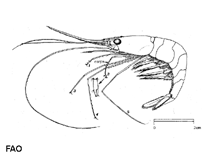Plesionika martia (Milne-Edwards, 1883)
Golden shrimp| Native range | All suitable habitat | Point map | Year 2050 |

|
| This map was computer-generated and has not yet been reviewed. |
| Plesionika martia AquaMaps Data sources: GBIF OBIS |
Classification / Names Common names | Synonyms | CoL | ITIS | WoRMS
Malacostraca | Decapoda | Pandalidae
Environment: milieu / climate zone / depth range / distribution range Ecology
Benthopelagic; depth range 165 - 2100 m (Ref. 97531), usually 400 - 600 m (Ref. 106425). Subtropical; 56°N - 51°S, 161°W - 180°E
Distribution Countries | FAO areas | Ecosystems | Occurrences | Introductions
Cosmopolitan: Western Atlantic: off South Carolina to Florida and off Bermuda; NE and SW Gulf of Mexico. Eastern Atlantic: off SW Ireland, Bay of Biscay, throughout Mediterranean, Gulf of Guinea, and Cape of Good Hope. Indo-West Pacific: from Gulf of Aden and east African coast to Japan and Hawaii; Plesionika martia orientalis: Indo-Pacific.
Length at first maturity / Size / Weight / Age
Maturity: Lm 1.6 range ? - ? cm Max length : 16.9 cm TL male/unsexed; (Ref. 434)
Life cycle and mating behavior Maturity | Reproduction | Spawning | Eggs | Fecundity | Larvae
Main reference
References | Coordinator | Collaborators
Fischer, W., G. Bianchi and W.B. Scott (eds.) 1981 Shrimps and prawns. 6: pag.var. In FAO species identification sheets for fishery purposes. Eastern Central Atlantic (Fishing Area 34, 47; in part). Canada Funds-in-Trust. Ottawa, Department of Fisheries and Oceans Canada, by arrangement with the Food and Agriculture organization of the United Nations. 1-7: pag.var. (Ref. 434)
IUCN Red List Status
(Ref. 130435: Version 2025-1)
CITES status (Ref. 108899)
CMS (Ref. 116361)
Threat to humans
Human uses
Fisheries: commercial
| FishSource |
Tools
More information
Max. ages / sizes
Length-weight rel.
Length-length rel.
Length-frequencies
Mass conversion
Abundance
Internet sources
BHL | BOLD Systems | CISTI | DiscoverLife | FAO(Publication : search) | Fishipedia | GenBank (genome, nucleotide) | GloBI | Gomexsi | Google Books | Google Scholar | Google | PubMed | Tree of Life | Wikipedia (Go, Search) | Zoological Record



